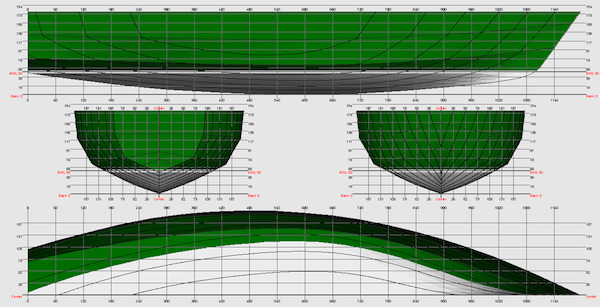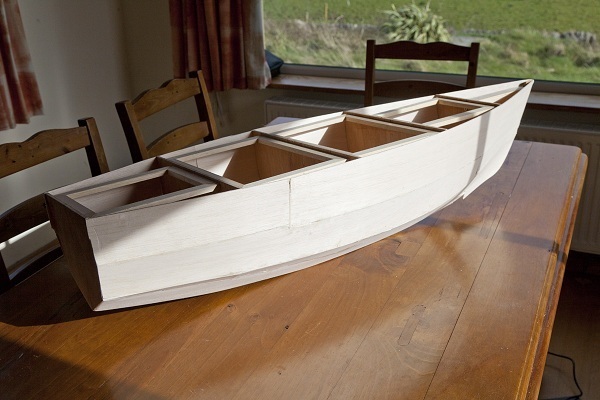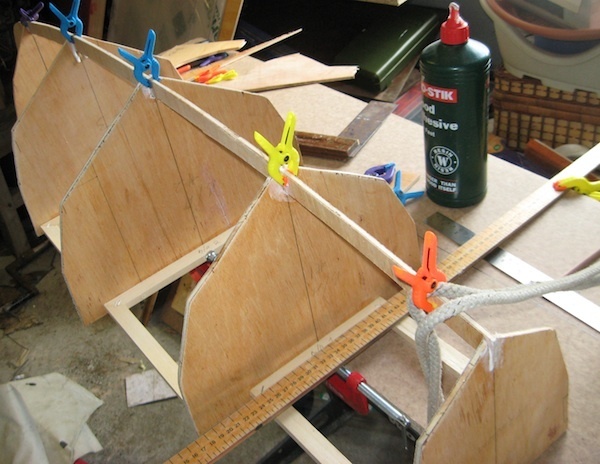
The hull starts to take shape.
By Dermot Tynan, almost 13 years ago.
On Henry's advice, the round hull of earlier designs has been discarded in favour of a hard-chined hull. We were originally planning a fibreglass hull from a round mould. The complexities of first producing a "plug" and preparing a mould from the plug, not to mention having to then fibreglass the hull itself, are quite involved. Henry suggested hard chines an 6mm marine ply for the construction, and a light bulb lit up.

Cutting out the Bulkheads.
By Dermot Tynan, over 12 years ago.
A slight change from the version of the hull from The hull starts to take shape.; the hull height from the base of the hull to the deck (not including the keel) was 180mm. As I started to look at cutting bulkheads and the transom, it struck me that the hull is quite shallow. It looks fine from DelftSHIP but that's a low freeboard.
The beam of the boat is around 360mm, which is twice that depth. The original intent was to create a hull which wasn't too "beam-y" but that's a 2:1 aspect ratio. I decided to increase the hull height by 50%. Luckily, DelftSHIP will scale your drawing in any or all of the three vertices. So, five minutes later, and we have a new hull with a 270mm depth.

The keel is attached.
By Dermot Tynan, over 12 years ago.
After much sanding and polishing of the keelson, and the frames for the hatches and top deck, the hull is starting to take shape.
The bulkheads are cut from 6mm exterior grade plywood. The wood which resembles a picture frame is pine, and it is used to hold the bulkheads and transom into a square position, and to provide additional strength to the hull. Eventually those frames will be covered over by 6mm ply on the deck.

The new rudder
By Dermot Tynan, about 12 years ago.
Thanks go to Colman Corrigan for designing and building the keel and rudder. The keel follows the traditional NACA shape, with a rounded leading-edge, tapering off to a narrow trailing edge. It is approximately a 6318 shape, with the maximum width being about 36% of the length of the cross-section. Overall, the keel is coming in at about 750mm from hull to the end of the bulb, and about 240mm from front to back. That's a 3:1 aspect ratio.

The First Sea Trial
By Dermot Tynan, about 12 years ago.
On September 1st, we launched the hull in Aughinish bay, without sails, rudder or electronics. The purpose was to see how the hull performed in open water, with the keel attached. As the keel wasn't properly attached or sealed in place, the main compartment flooded with water, but as the compartments are individually water-tight, this wasn't an issue. It did lower the boat in the water somewhat, but not to any significant degree.
Upcoming Missions
- Galway Bay Loop, Waiting for Vessel Availability
Search
Recent Posts
- May 2023 (1 post)
- April 2023 (1 post)
- March 2023 (1 post)
- February 2023 (2 posts)
- March 2022 (3 posts)
- March 2021 (1 post)
- August 2020 (1 post)
- May 2019 (1 post)
- April 2018 (1 post)
- November 2017 (1 post)
- April 2017 (1 post)
- November 2016 (1 post)
- September 2016 (1 post)
- August 2016 (1 post)
- January 2014 (2 posts)
- October 2013 (7 posts)
- September 2013 (1 post)
- August 2013 (3 posts)
- June 2013 (3 posts)
- May 2013 (4 posts)
- April 2013 (3 posts)
- March 2013 (9 posts)
- February 2013 (8 posts)